Description
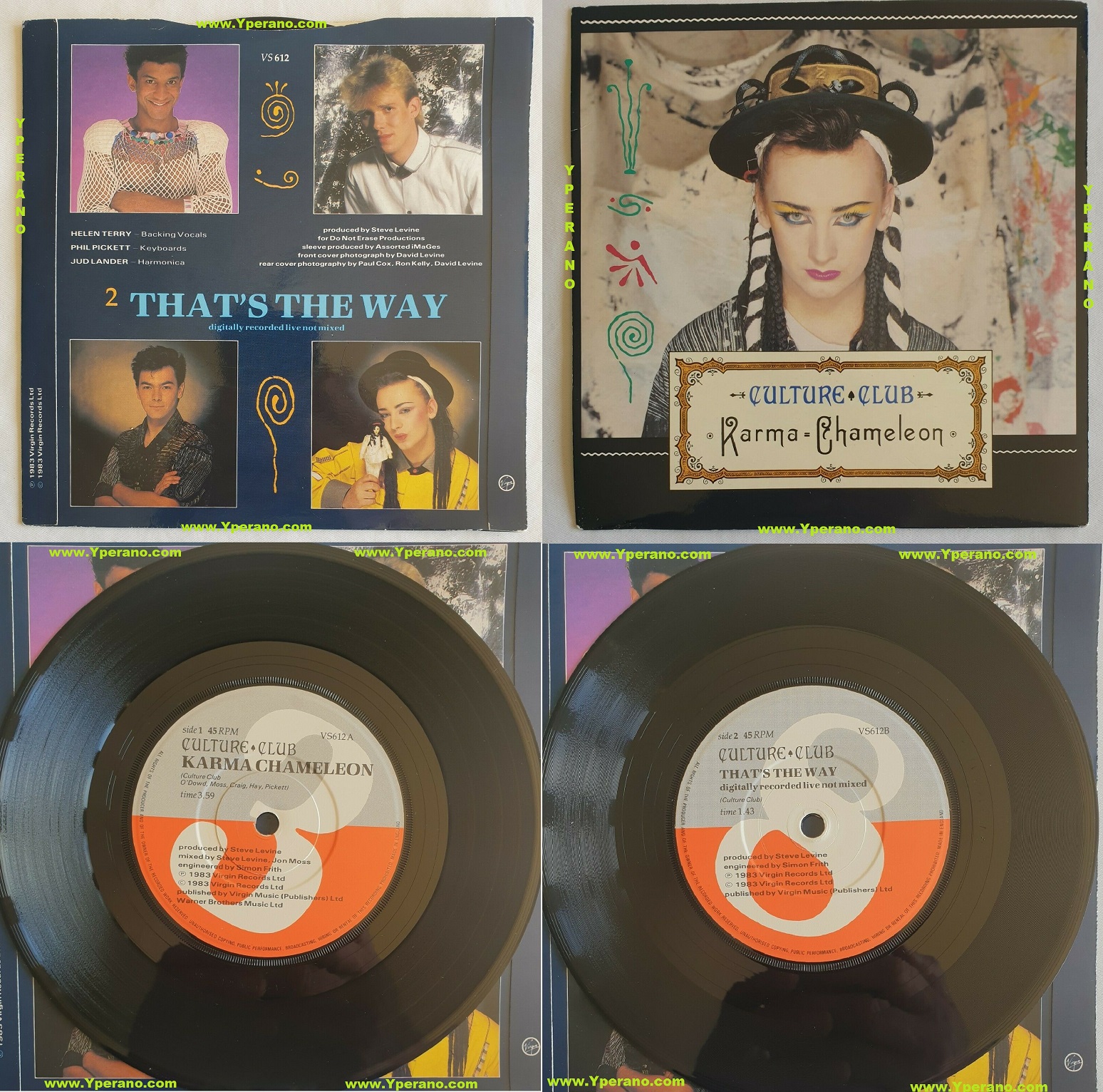
Length Karma Chameleon 3:51 (single edit)
B-side “Thats the Way (I’m Only Trying to Help You)”
Released 5 September 1983
Format 7″,
Recorded 1983
Genre Folk rock, new wave
Label Virgin
Writer(s) George O’Dowd, Jon Moss, Mikey Craig, Phil Pickett, Roy Hay
“Karma Chameleon” is a song by British New Wave band Culture Club, featured on the groups 1983 album Colour by Numbers. The song spent three weeks at number one on the US Billboard Hot 100 in 1984, becoming the groups biggest hit and only US number one. “Karma Chameleon” hit number one in sixteen countries worldwide. In the groups home country, it became the second Culture Club single to reach the top of the UK singles chart (after “Do You Really Want to Hurt Me”), where it stayed for six weeks in September and October 1983, and became the biggest-selling single of 1983. It is widely regarded as Culture Clubs signature song.
In an interview, Culture Club frontman Boy George explained: “The song is about the terrible fear of alienation that people have, the fear of standing up for one thing. Its about trying to suck up to everybody. Basically, if you aren’t true, if you don’t act like you feel, then you get Karma-justice, thats natures way of paying you back.” The prominent harmonica part was played by Judd Lander, who had been a member of Merseybeat group The Hideaways in the 1960s. The song was originally to be called “Cameo Chameleon”.
Likely because of the lyric “I’m a man without conviction,” and the chorus, which includes the word chameleon, “Karma Chameleon” has been used by several politicians in political ads. In 2006, Britains Labour Party used “Karma Chameleon” as the theme song for a series of political advertisements against Conservative party leader David Cameron in the 2006 UK Elections.
The song won Best British Single at the 1984 Brit Awards. The group performed the song as a finale when they appeared in the 1986 episode “Cowboy George” of The A-Team.
The “Karma Chameleon” music video was filmed at Desborough Island in Weybridge during the summer of 1983. According to caption, the video is set in Mississippi in 1870, and depicts people in colourful costumes, including dancers in “red, gold and green”, waiting on a riverbank. Boy George is dressed in a colourful costume and is depicted singing the title song. A pickpocket is seen wandering through the crowd.
A riverboat, The Chameleon, arrives and people board. A game of cards takes place, as Boy George continues to sing in the background. The pickpocket is discovered cheating and is forced to walk the plank. Throughout the video, black and white people are shown singing and dancing together.
Chart positions Country Peak position
Australia 1
Austria 3
Belgium 1
Canada 1
Denmark 1
European 1
Germany 2
Ireland 1
Italy 4
Netherlands 1
New Zealand 1
Norway 1
Sweden 1
Switzerland 1
United Kingdom 1
United States 1
The Story of… ‘Karma Chameleon’ by Culture Club
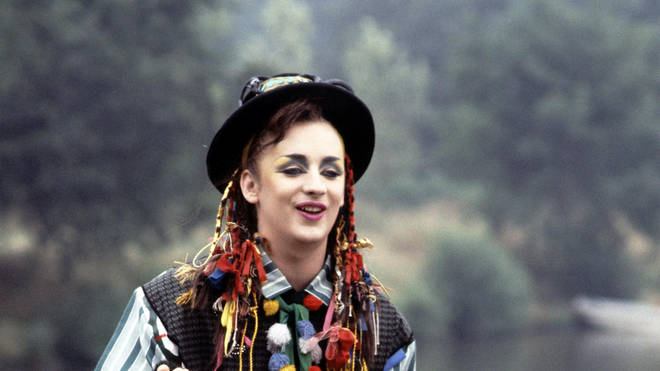
Their song ‘Karma Chameleon’ was a huge hit around the world, and Boy George‘s androgynous appearance and soulful voice inspired many artists, and helped further the New Romantic movement.
But what was their number one song actually about? Here’s all the fascinating facts:
-
Who wrote ‘Karma Chameleon’?
The song was written by Culture Club members Boy George, Jon Moss, Mikey Craig, Roy Hay and Phil Pickett.
It was recorded for the group’s second album Colour by Numbers, released in 1983.
-
What is the meaning behind ‘Karma Chameleon’?
Boy George once explained about the song: “The song is about the terrible fear of alienation that people have, the fear of standing up for one thing.
“It’s about trying to suck up to everybody. Basically, if you aren’t true, if you don’t act like you feel, then you get Karma-justice, that’s nature’s way of paying you back.”
Boy George wrote most of the band’s lyrics, and many of his words were inspired by his relationship with the group’s drummer, Jon Moss.
Their difficult romantic/professional relationship was also the inspiration for the line: “You’re my lover, not my rival” in ‘Karma Chameleon’.
The relationship was hidden to the public, so it became an outlet for Boy George to communicate with him through their songs.
-
It was alleged to have plagiarised another song
In response to claims from singer-songwriter Jimmy Jones that the song copies his hit ‘Handy Man’, George said: “I might have heard it once, but it certainly wasn’t something I sat down and said, ‘Yeah, I want to copy this.'”
-
Culture Club members weren’t big fans at first
Speaking to 60 Minutes Australia, Boy George revealed he wrote the song while he was on holiday in Egypt.
The other members of Culture Club weren’t too pleased about recording it at first, as they felt it sounded like a country and western song.
-
Who played the harmonica part?
The harmonica was played by Judd Lander, who was also a member of Merseybeat group The Hideaways in the 1960s.
Lander also provided the harmonica on Culture Club’s ‘Church of the Poisoned Mind’ and ‘Say You’ll Be There’ by Spice Girls.
-
Where was the music video filmed?
Directed by Peter Sinclair, the video filmed at Desborough Island in Weybridge during the summer of 1983.
The video is set in Mississippi in 1870, and shows a large multiracial group of people in late 1800s outfits, including some dressed in red, gold, and green (as referenced in the song’s lyrics).
Boy George is dressed in his signature look of colourful costumes, fingerless gloves, long braids, and a black bowler hat.
The video shows a pickpocket and jewellery thief stealing from victims. The band and others board a riverboat, called The Chameleon.
While four men are playing poker, the thief is discovered cheating and is forced to walk the plank.
-
How did it perform in the charts?
In the UK, it was their second number one after ‘Do You Really Want to Hurt Me’, staying at the top for six weeks and becoming the UK’s biggest-selling single of 1983.
It is still one of the best-selling songs of all time, selling 1.52 million copies in the UK alone, and over 5 million globally.
***
“I’m a man who doesn’t know how to sell a contradiction,” Boy George sang. Au contraire. On the early-’80s pop landscape, there might have been nobody better at selling contradictions.
When American listeners were only just moving beyond the anonymous studio-rock of the late ’70s and early ’80s, Boy George must’ve looked like a mirage, a purring androgyne flirt who used the brand-new vehicle of MTV to present a persona that was defiant in its femininity. When I was in middle school in the early ’90s, people were still making homophobic Boy George jokes, even though his band Culture Club had faded into pop’s past. But in the early ’80s, Culture Club turned ingrained systemic homophobia against itself, putting forward an image and a sound that was so proudly different that people had to pay attention.
Another contradiction: While the members of Culture Club all came from London’s punk and new wave scenes, they made tender crushed-velvet white soul that was sonically unchallenging enough to do well on American adult contemporary radio, not exactly a welcoming environment for gender-bending iconoclasts. Their softness might’ve been radical, but it also helped make them stars.
Culture Club really sold those contradictions, too. For a few years, Culture Club weren’t simply a novelty; they were a pop juggernaut. Between 1982 and 1984, Culture Club released three platinum albums and landed six singles in the Billboard top 10. I don’t even especially like Culture Club’s music, but their ability to dominate in a time of rampant homophobia is pretty amazing, and it speaks to Boy George’s singular charisma.
George Alan O’Dowd had been born into a working-class Irish Catholic family in Kent. (The #1 single in the US when George was born: Ricky Nelson’s “Travelin’ Man.”) George’s father was abusive, and he also had to deal with growing up gay in a profoundly unfriendly environment. But he found escape in the New Romantic world of the early ’80s, dancing at clubs like London’s Blitz.
One night at Blitz, the former Sex Pistols svengali Malcolm McLaren saw George and invited him to sing with Bow Wow Wow, the band McLaren was managing at the time. (In the US, Bow Wow Wow’s highest-charting single is their 1982 cover of “I Want Candy,” a Strangeloves song that had gone to #11 in 1965. Bow Wow Wow’s version peaked at #62.) George, using the stage name Lieutenant Lash, did not last long in Bow Wow Wow. Instead, he left to start his own band, enlisting Bow Wow Wow bassist Mikey Craig. They also signed on guitarist Roy Hay, a former hairdresser, and drummer Jon Moss, who’d already played in the Stranglers, the Damned, and Adam And The Ants. For a minute, the new band going to call itself Sex Gang Children. They went with Culture Club instead.
Culture Club broke through huge with their 1982 single “Do You Really Want To Hurt Me?,” a sweetly sensitive lite-reggae bounce that became a global smash. “Do You Really Want To Hurt Me?” went to #1 in nine countries, including the UK, and it peaked at #2 in the US. (It’s an 8.) Culture Club’s next single, “Time (Clock Of The Heart),” also peaked at #2. (That one is a 6.) Culture Club’s timing was good. They’d arrived just as MTV was starting to take over, and Boy George was the kind of telegenic figure that the network needed. By the time they released their sophomore album Colour By Numbers in October 1983, Culture Club were already stars.
Culture Club didn’t sound like other new wave groups. They used synths, but they didn’t use them for stark, confrontational purposes. (The mere existence of Boy George was already confrontational enough.) Musically, Culture Club were probably closer to Lionel Richie than to the Human League. The group made a lush, reassuring sort of white soul, occasionally sprinkled with soft reggae or post-disco dance-pop accents. Boy George sang as much like Smokey Robinson as he could, shooting for that same soft precision and that same sense of strength through vulnerability. He was and is a far clumsier singer than Robinson, but he had a similar gift of hiding deep sadness in plain sight, translating it into upbeat and down-the-middle pop songs.
“Karma Chameleon,” like a lot of Culture Club songs, is a disguised lament about the tempestuous relationship between Boy George and his bandmate Jon Moss. At the time, George wasn’t fully out of the closet — he claimed to be bisexual — and he kept it secret that he and Moss were a couple. George told The Los Angeles Times that “Karma Chameleon” was “about this terrible fear of alienation that people have, the fear of standing up for one thing.” Maybe. But it’s also pretty clearly about an unhappy couple with a fucked-up balance of power: “When we cling, our love is strong/ When you go, you’re gone forever/ You string along, you string along.”
There’s a deep ache in “Karma Chameleon”: “Loving would be easy if your colors were like my dreams/ Red, gold and green.” George pleads for mutual support in the face of a hostile world: “Everyday is like survival/ You’re my lover, not my rival.” But he sings it with a breezy sort of charm, twisting its hook into a near-gibberish refrain. It sounds like an easy, carefree song — an impression only helped along by the video, a live-action cartoon that takes place in a ridiculous alternate-reality multi-cultural version of 19th-century Mississippi, where Culture Club catch a con man on a riverboat casino and throw him overboard. (Director Peter Sinclair filmed the video on the Thames, not the Mississippi.)
The members of Culture Club all shared songwriting credit on “Karma Chameleon,” but George says that he wrote it while on vacation in Egypt. George also claims that the rest of the band thought the song was too country when he played it for them. I don’t hear “Karma Chameleon” as a country song at all, despite the constant, aggravating harmonica-tootles of session player and Merseybeat veteran Judd Lander. Instead, “Karma Chameleon” sounds like only the most plastic version of uptempo American soul.
There’s at least a chance that “Karma Chameleon” is a plastic version of a specific uptempo American soul song: “Handy Man,” a Jimmy Jones single that peaked at #2 in 1960. (“Handy Man” is a 5.) Boy George’s “karma-karma-karma” bit sounds a whole lot like Jones’ “come-ah come-ah come-ah,” and the song swings along at a similar tempo. Jones and “Handy Man” co-writer Otis Blackwell sued Culture Club, and the group settled. But Boy George has said that he didn’t intentionally steal anything from “Handy Man” and that Culture Club “gave them 10 pence and an apple.”
“Karma Chameleon” hit #1 in even more countries than “Do You Really Want To Hurt Me?” had done, and it was the UK’s biggest-selling single of 1983. In the US, “Karma Chameleon” helped push Colour By Numbers to quadruple platinum sales, and Culture Club won the Best New Artist Grammy in 1984. Accepting the award via satellite, Boy George said, “America, you’ve got taste, style, and you know a good drag queen when you see one.”
But Culture Club only scored one more top-10 single in the US: The follow-up single “Miss Me Blind,” which peaked at #5 later in 1984. (It’s a 6.) The group’s later records sold less and less. Boy George and Jon Moss split up, and George tumbled into heroin addiction. In 1986, the group ended.
Boy George went on to a solo career, and he enjoyed a bit of a resurgence in 1992, when his theme for the film The Crying Game peaked at #15. He also messed around with dance music and eventually found a steady career as a DJ. He collaborated with a pretty amazing range of people, including Afrika Bambaataa, Faithless, and Antony And The Johnsons, as well as with PM Dawn and Mark Ronson, two artists that will eventually appear in this column. Boy George also did a few months in prison in 2008 for handcuffing a Norwegian male escort to a wall and beating him up with a chain.
Culture Club have reunited a few times over the years, though never without drama. In 2006, for instance, the other members of the group tried to stage a Culture Club tour with a different singer; Boy George was not amused. There were not-very-successful reunion albums in 1999 and 2018, and Jon Moss recently filed a lawsuit against the rest of the group. After all that, it’s easy enough to forget what Culture Club were able to accomplish at their peak. But they really did have a run.
BONUS BEATS: Here’s the bugged-out digital-reggae cover of “Karma Chameleon” that dancehall pioneer Wayne Smith released in 1983:
And here’s the dancehall version of “Karma Chameleon” that Wayne Wonder released in 1992:
(Wayne Wonder’s highest-charting single, 2003’s “No Letting Go,” peaked at #11.)
BONUS BONUS BEATS: Culture Club guested on a pretty hilarious 1986 episode of The A-Team; here’s the scene where they play “Karma Chameleon” in a rowdy cowboy bar:
BONUS BONUS BONUS BEATS: Here’s Lil Wayne singing a bit of “Karma Chameleon” on his 2005 mixtape track “Do It”:
(Lil Wayne will eventually appear in this column.)
BONUS BONUS BONUS BONUS BEATS: Here’s the bit from 2006’s Scary Movie 4 where a giant iPod rises up out of the street and briefly plays “Karma Chameleon” before turning into a murderous robot:
BONUS BONUS BONUS BONUS BONUS BEATS: Here’s Me First And The Gimme Gimmes’ 2014 snot-punk cover of “Karma Chameleon”:

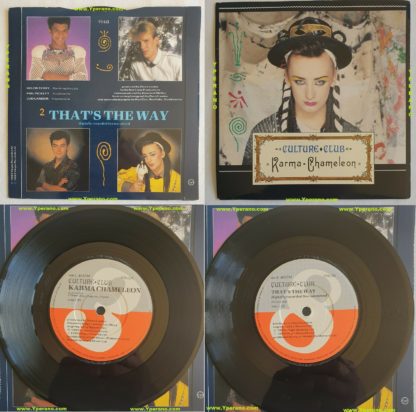









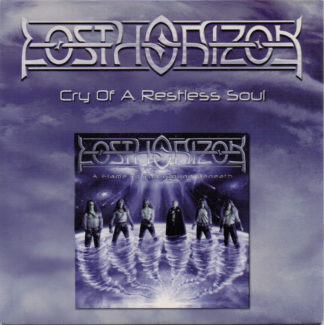
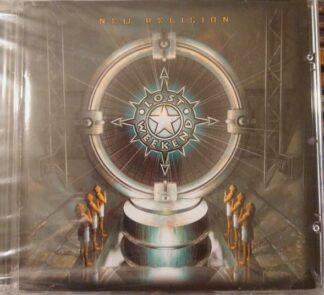
![LOVE.45: Larger Than Life CD [Alternative, Pop, Rock, hard rock + Elvis Presley cover] ..](https://yperano.com/wp-content/uploads/2016/03/18110-LOVE.45-Larger-Than-Life-CD-Alternative-Pop-Rock-hard-rock-Elvis-Presley-cover.jpg)
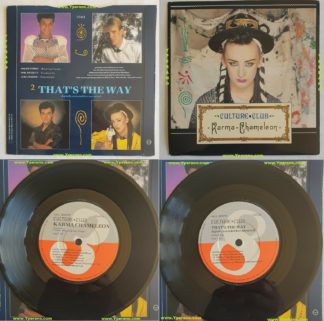


Reviews
There are no reviews yet.